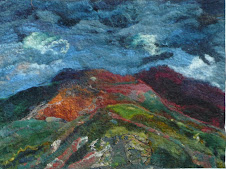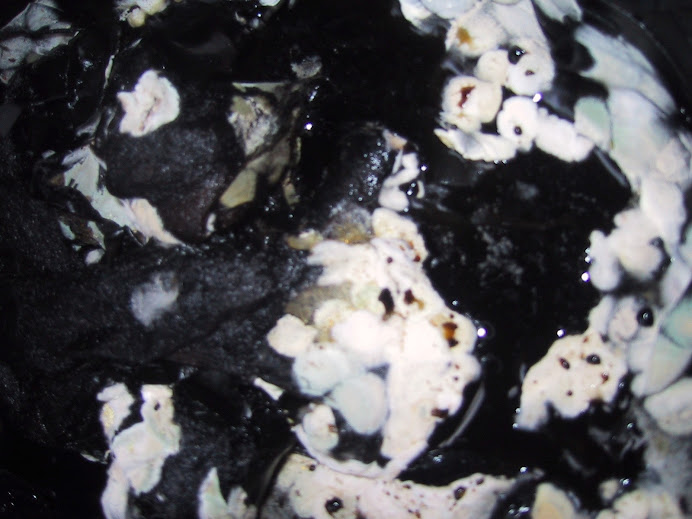
Here are the results of dyeing with cosmos from my garden .
I picked 300g of flower heads, covered with tap water in my traditional style slow cooker and left this on overnight. The advantage of this slow cooker is that unlike the more modern electric casserole it does not reach boiling but heats to between 80 & 90 degrees C and can therefore be left on overnight without too much fear that the studio will burn down and the colour will be spoiled by boiling. I allowed ( this really means that I was to busy to do anything with it ) it to cool, when the bath was red and then dumped in what I had left in my mordant pot which turned out to mixed fibres of silk laps, Lesley Prior 's Bowmont, teeswater fleece and some 18.5 micron merino. These had been mordanted in 8% alum, 7%cream of tartar and I left them to heat gently for about 24 hours before removing. This morning when I came to check, the dye bath was a soft yellowy green which for some reason does not show up well in the photos. I made samples as follows. I remove about a 100ml - (this is quite approximate incidentally)- of liquid and added to it appropriate chemicals as follows. A small glug of ammonia ( about 5ml) ), a 1/16 teaspoon of stannous chloride , the same plus ammonia, 1/16 of copper sulphate and the same plus ammonia , 1/16th teaspoon of ferrous sulphate and the same plus ammonia. I then gave these a minute in the microwave to provide some gentle heat, remove the fibres rinsed and labelled. The ammonia turned the dye bath a deep gold so I added a glug to the main bath and took a photo after about half an hour of gentle heat. 


 I probably dyed about 100-150g of fibres but I will check tomorrow when they are dry. I have not obviously done light fastness tests yet but according to John and Margaret Cannon -Dye Plants and Dyeing published by Kew Garden, cosmos sulphurous (my cosmos is in the same genus), is in the same dye group as coreopsis tinctoria and dahlia. Originally they came from Mexico and were used by the Aztecs before the Spanish invaded Central America. I first grew these plants because my mother in the last few years of her life grew them and they reminded me of her. Enys and I think I brought a packet of seeds and handed them to her but we both have been very pleased with them. They obviously have enjoyed the wet summer which is surprising as my mother lived in dry Surrey but they have been fantastic this year. So another dye plant which , like dyers chamonile, coreopsis tinctoria , lythrum salicaria and to a lesser degree genista tinctoria, is both beautiful and useful. The picked plants are already flowering again so will no doubt go in giving pleasure till the frosts come.
I probably dyed about 100-150g of fibres but I will check tomorrow when they are dry. I have not obviously done light fastness tests yet but according to John and Margaret Cannon -Dye Plants and Dyeing published by Kew Garden, cosmos sulphurous (my cosmos is in the same genus), is in the same dye group as coreopsis tinctoria and dahlia. Originally they came from Mexico and were used by the Aztecs before the Spanish invaded Central America. I first grew these plants because my mother in the last few years of her life grew them and they reminded me of her. Enys and I think I brought a packet of seeds and handed them to her but we both have been very pleased with them. They obviously have enjoyed the wet summer which is surprising as my mother lived in dry Surrey but they have been fantastic this year. So another dye plant which , like dyers chamonile, coreopsis tinctoria , lythrum salicaria and to a lesser degree genista tinctoria, is both beautiful and useful. The picked plants are already flowering again so will no doubt go in giving pleasure till the frosts come.



























I found that really interesting thanks. lou x
ReplyDeleteWow! I've grown cosmos before but never dyed with them. I'll have to remember this.
ReplyDeleteI definitely will try the flowers of pink cosmos next year, the colour with ammonia is very pretty! thanks for the results! I have to get cracking with my dyer's knotweed over the weekend, because we are having early frosts at night! thankfully I grow it in the tunnel - so I am hopeful that it survives the single frosty night....
ReplyDeleteIt may be that it is not very light fast. Reading Dominique Cardon on coreopsis the aurones are notoriously subject to fading and this is one of the chemical that gives the orangey yellow she says. having said that I do think it is a must for the dyers garden as it has supplied lots of lovely colour in autumn and despite two frost there is still flowering! and the colour is nice!
ReplyDeleteI have never done cosmos - my mother in law grows them - I will have to snip her stash next year.
ReplyDeleteFortunately the more flowers you pick the more the plant produces!
ReplyDeleteI love to grow cosmos, thank you I am going to buy more seed this spring, and try this. I am learning much from your posts-thank you so much for sharing Kathyinozarks
ReplyDelete